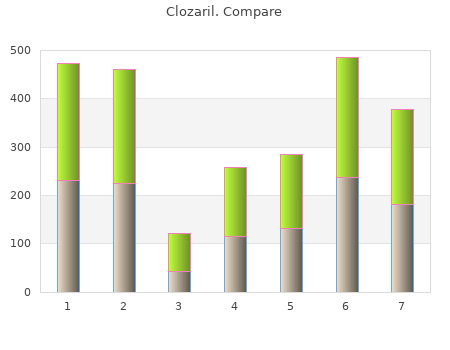2017, Landmark College, Bram's review: "Clozaril 100 mg, 50 mg, 25 mg. Safe Clozaril no RX.".
Intrathecal baclofen therapy is the delivery of microgram amounts of baclofen buy clozaril 100 mg cheap, a GABA agonist discount clozaril 100mg with visa, into the intrathecal space via an implanted, programmable pump. Intrathecal baclofen provides titratable reductions in spasticity using doses 100 times less than oral doses, and with a lack of adverse effects often associated with higher doses of oral baclofen. Prior to pump placement, a 50 mg bolus of baclofen is fre- quently given by lumbar puncture, with a 6–8 hr period of close observation for reductions in spasticity. At the time of pump insertion, catheter placement is impor- tant, with higher placement associated with greater benefit to the upper extremities. While there are reports of functional improvements in children with spastic diplegia using ITB, replication of findings in large prospective, randomized trials has not been done to date. Effective management requires a team approach before, during, and after pump placement. Risks, treatment goals, and parental expectations of benefit should be completely outlined prior to surgery. After pump placement, ongoing surveillance for potentially serious side effects includes severe acute withdrawal secondary to, increased hypertonicity associated with catheter kinking or dislodgement; and CNS depression or loss of function from excessive dosing is required. Selective dorsal rhizotomy is a surgical procedure in which 30–50% of sensory nerve fibers entering the lumbosacral cord are selectively cut, to reduce lower extre- mity spasticity and improve function. Some surgeons utilize intraoperative nerve sti- mulation to determine which rootlets to cut, while others feel this is not required. Selective dorsal rhizotomy has been recommended where there is significant spasti- city, but motor strength is well preserved. The ideal patient is between 4 and 10 years of age, with relatively pure spastic diplegia, preservation of antigravity strength and selective motor control.


In the USA order clozaril 25 mg amex, President Richard Nixon had declared ‘war on cancer’ in 1970 buy clozaril 50 mg on-line, but survival rates remained substantially unchanged. Medical research in teaching hospitals was exposed and denounced as ‘a vehicle for self-advancement rather than bettering the patient’s condition’ (Lock 1997:136). In 1971, Macfarlane Burnet, Nobel laureate and founding father of immunology, offered a gloomy prognosis for the discipline he had done much to create, concluding that it had little potential for dealing with the new pattern of disease and arguing that the future lay in the social rather than the biological sciences (Burnet 1971). Up to the early 1970s the problems of the epidemiological transition and the difficulties facing medical science remained for the most part matters of controversy within the world of medicine itself. However, these events unfolded in the context of major social changes affecting all Western societies. By the late 1960s the long post-war economic boom was coming to an end and in the early 1970s all Western economies went into recession, with the return of inflation and unemployment on a scale not seen since the 1930s. The 134 THE CRISIS OF MODERN MEDICINE resulting upsurge in trade union militancy in Europe was linked to a wider youthful radicalisation across the Western world, most conspicuously in the USA, where it was linked to causes of black civil rights, women’s liberation and opposition to the Vietnam War. From the late 1960s onwards, conditions of social stability and political consensus that had prevailed for more than two decades began to break down, with wide-ranging consequences, for doctors and health care systems as for other institutions in society. In terms of the effects of these social forces on medicine, the 1970s can be divided into two phases: an early radical, optimistic, phase and a later phase of conservative reaction in which a more pessimistic outlook became increasingly influential. The radical challenge One of the central principles of the radical upsurge symbolised by the May 1968 events in Paris was the commitment to self-expression and to the assertion of individuality against structures of society perceived as authoritarian and oppressive. In the USA, where the collectivist traditions still upheld by labour movements in Europe were conspicuously weak, and individualistic values were deeply rooted in popular culture, the youthful assertion of individuality took a particularly vigorous form. As the civil rights cause lost momentum as a protest movement in the 1970s, it offered a model for a range of ‘new social movements’ advocating the rights of women, students, gays, children, benefit claimants and many more. In what Starr characterised as a ‘generalisation of rights’ there was a dramatic expansion in both the ‘variety and detail’ of rights demanded: Medical care figured prominently in this generalisation of rights, particularly as a concern of the women’s movement and in the new movements specifically for patients’ rights and for the right of the handicapped, the mentally ill, the retarded and the subjects of medical experiments. No such right had ever been recognised in law, least of all in the USA, where access to health care was strictly 135 THE CRISIS OF MODERN MEDICINE controlled according either to the insurance principle or to strict eligibility criteria for state welfare services. Nevertheless, the claim for health care as a right was ‘for a time so widely acknowledged as almost to be uncontroversial’.

Such uncooperative behaviour should not be attributed automatically to alcohol clozaril 50 mg on-line, as hypoxia and shock may be responsible and must be treated purchase clozaril 50 mg with visa. If no spinal board is used and the airway is unprotected, the modified lateral position (Figure 1. In the absence of life-threatening injury, patients with spinal injury should be transported smoothly by ambulance, for reasons of comfort as well as to avoid further trauma to the spinal cord. They should be taken to the nearest major emergency department but must be repeatedly assessed en route; in particular, vital functions must be monitored. In transit the head and neck must be maintained in the neutral position at all times. If an unintubated supine trauma patient starts to vomit, it is safer to tip the casualty head down and Figure 2. However, patients can be turned safely and rapidly by a single rescuer when strapped to a spinal board and that is one of the advantages of this device. Hard objects should be removed from patients’ pockets during transit, and anaesthetic areas should be protected to prevent pressure sores. The usual vasomotor responses to changes of temperature are impaired in tetraplegia and high paraplegia because the sympathetic system is paralysed. The patient is therefore poikilothermic, and hypothermia is a particular risk when these patients are transported during the winter months. A warm environment, blankets, and thermal reflector sheets help to maintain body temperature. If a helicopter is used, the possibility of immediate transfer to a regional spinal injuries unit with acute support facilities should be considered after discussion with that unit. Initial management at the receiving hospital Primary survey When the patient arrives at the nearest major emergency department, a detailed history must be obtained from ambulance staff, witnesses, and if possible the patient. Simultaneously, the patient is transferred to the trauma trolley and this must be expeditious but smooth. Alternatively a scoop stretcher can be Head injuries (coma of more than 6 hours’ duration, used for the transfer but this will take longer.




